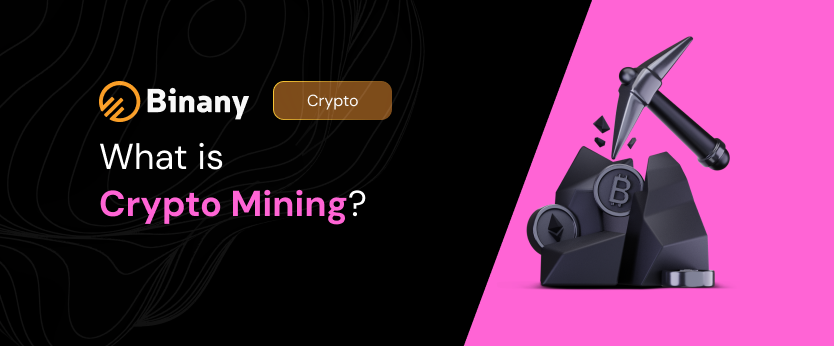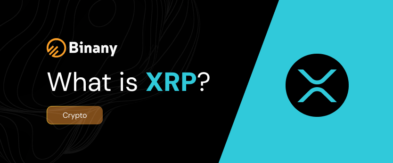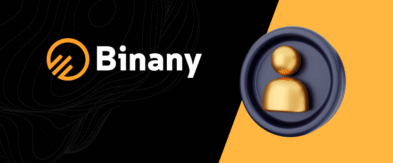What Is Crypto?
Crypto mining is the process of creating new cryptocurrency units, simultaneously ensuring that transactions are verified and recorded on a distributed blockchain network. Every time a cryptocurrency transaction occurs, miners verify its validity and add it to a public ledger called a blockchain.

For those wondering what crypto mining is, the essence of the process is using computing power to solve complex mathematical problems. Miners are rewarded with new coins for verifying blocks of transactions. This process keeps cryptocurrency networks functional and ensures security and decentralisation, protecting the system from hacks and fraud.
Crypto mining has become especially important in networks with a Proof of Work algorithm, such as Bitcoin. In PoW, miners compete to create a new block, which requires significant energy and computing resources.
How Does Crypto Mining Work?
Understanding the basic principles is essential for understanding how crypto mining works. Cryptocurrency mining involves using powerful computers to solve cryptographic problems. These problems verify the authenticity of transactions and protect the network from data duplication. Once a miner solves the problem and finds the correct hash, the block with transactions is added to the blockchain, and the miner receives a reward.
Here’s how mining works:
- Transactions are sent to the network: When a user makes a transaction, the information is sent to the blockchain network, where miners accept it.
- Creating a block of transactions: Miners collect transactions and combine them into a block.
- Solving a mathematical problem: Miners begin searching for the correct hash that matches the set parameters of the network.
- Adding a block to the blockchain: Once one of the miners finds the correct hash, the block is added to the blockchain, and that miner receives a reward.
People often ask how to start crypto mining. Specialised hardware and software are needed. Miners can work individually or in pools, combining capacities to increase their chances of success. Popular coins for mining are Bitcoin, Ethereum, Litecoin, and others.
How To Start Mining Crypto?
For those interested in how to start mining crypto, the first thing to do is to choose the right hardware. Mining requires a lot of computing power, so powerful graphics processing units (GPUs) or specialized ASIC devices that perform well when solving cryptographic problems are best suited for this process.
The main steps to start mining:
- Choosing hardware: The first thing you must do is select your mining hardware. ASICs (Application-Specific Integrated Circuits) are specifically designed for mining and are most effective for cryptocurrencies such as Bitcoin. However, using video cards (GPUs) for other coins, such as Ethereum, is better.
- Software: Once you have chosen your hardware, you must install mining software. Popular programs include CGMiner, BFGMiner, and EasyMiner.
- Choosing a mining pool: To increase the chances of success, many miners join pools that allow them to mine cryptocurrency collectively. This is especially useful for beginners, as more than mining alone can be slow and less profitable.
- Create a cryptocurrency wallet: You must create one to receive mining rewards.
Sometimes, people wonder if it is possible how to do crypto mining on phone. Although several applications allow you to mine cryptocurrency on mobile devices, such as MinerGate or CryptoTab, this is hugely inefficient. Mobile devices have low computing power, and earnings from such mining are minimal.
What Do Crypto Miners Do?
For those wondering what is crypto miner, cryptocurrency miners perform several essential tasks that are the basis for the functioning of decentralized blockchain networks. They process and confirm transactions, creating new blocks, which in turn maintain the security and stability of the cryptocurrency ecosystem.
Some of the primary responsibilities of a crypto miner include:
- Transaction verification: Every cryptocurrency transaction, whether a purchase, sale, or transfer of crypto assets, must be verified. Miners are assigned this task, and they check the legitimacy of transactions before including them in a block. The verification process ensures the sender has the necessary funds to complete the transaction.
- Creating new blocks: Once miners have verified the transactions, they combine them into a new block. Each block contains a set of transactions and becomes part of a chain of blocks called a blockchain. However, before a block can be added to the chain, miners must solve a complex mathematical problem.
- Solving cryptographic puzzles: To add a block to the blockchain, miners must find the correct hash, which must meet certain conditions set by the network. Miners continuously search for a solution by trying different options until one of them considers the desired value.
- Receiving a reward for mining: When a miner solves a cryptographic puzzle and adds a new block to the blockchain, he gets a cryptocurrency reward. This reward, called a «block reward», incentivises miners to keep the network running.
- Securing the network: One of the critical functions of miners is to ensure the security of the cryptocurrency network. Decentralised networks need distributed participants to protect from attacks and fraud. The more miners participate in the process, the more difficult it is for attackers to gain network control.
- Maintaining decentralisation: Miners are distributed worldwide, which makes cryptocurrency networks decentralised. This is a crucial advantage of cryptocurrencies, as the absence of a central controlling body protects the network from centralised influence or control.
- Energy consumption and environmental impact: Mining requires significant computing power, which is associated with high energy costs. Many miners strive to use renewable energy sources to reduce their environmental impact.
Crypto miners can mine in different ways, depending on their goals and resources:
- Solo mining;
- Pool mining;
- Cloud mining;
- Green mining.
Thus, crypto miners are crucial in supporting and developing cryptocurrency networks. They not only help confirm transactions and create new blocks but also ensure the security and decentralization of the network, protecting it from attacks and abuse.
How To Sell And Exchange Cryptocurrency?
Once you have accumulated cryptocurrency through mining or purchasing, the next step may be to sell or exchange it. Today, many cryptocurrency exchanges allow you to easily trade cryptocurrency for fiat money or other digital assets. One such platform is Binany.
To begin with, let’s define what is crypto exchange. It is a platform where users can buy, sell, or exchange cryptocurrency. Such exchanges act as intermediaries between buyers and sellers, providing transaction security and a user-friendly interface for asset management.
How to sell or exchange cryptocurrency on the Binany platform:
- Creating an account: First, you must register on Binany and provide your personal information to verify your identity.
- Deposit funds: After registration, you can deposit cryptocurrency into your account.
- Choosing a trading pair: To exchange your cryptocurrency for fiat money, you can select the BTC/USD or ETH/USD trading pair.
- Placing an order: You can create a market order to sell or a limit order to set your price.
- Withdrawal: Once the sale is completed, you can withdraw your funds to a bank card or e-wallet.
If you are considering how to start a crypto exchange, remember that it requires significant technical skills and investment. You also need to ensure high security, create a user-friendly platform, and comply with legal requirements.

Financial writer and market analyst with a passion for simplifying complex trading concepts. He specializes in creating educational content that empowers readers to make informed investment decisions.



